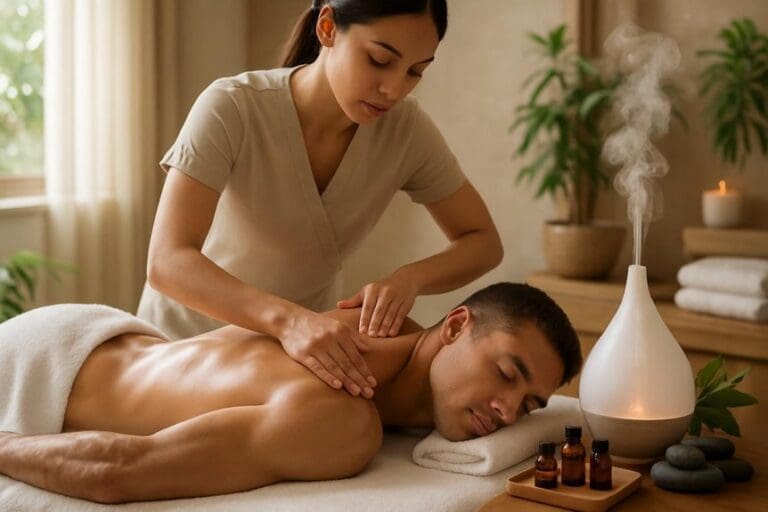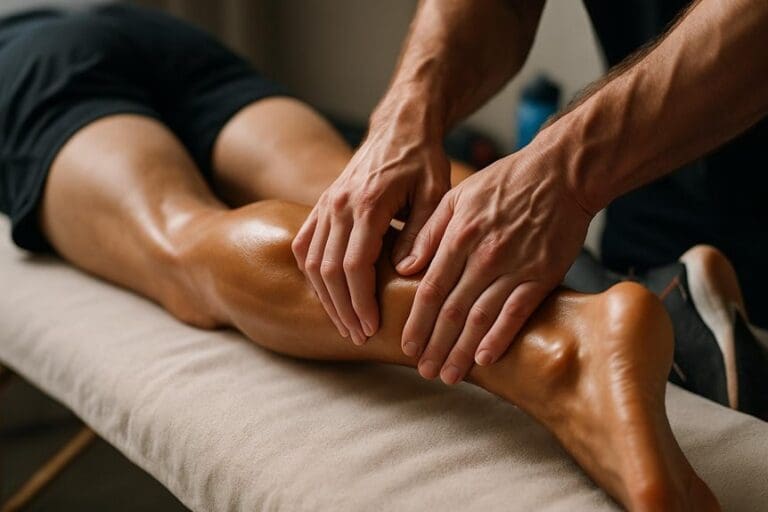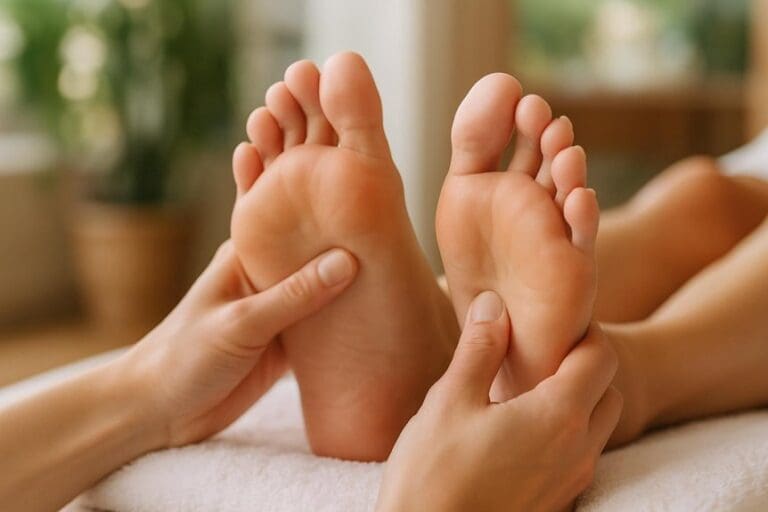This therapy operates by applying systematic pressure to specific reflex points on the feet, hands, or ears, which are believed to correspond with distinct organs and body systems. This targeted stimulation aims to promote physiological balance, enhance circulation, and support the body’s natural healing processes. Therapists use precise thumb and finger techniques to induce relaxation and facilitate homeostasis. Understanding the detailed connections between reflex zones and bodily functions offers further insights into the benefits and practice of this technique.
The Principles Behind It
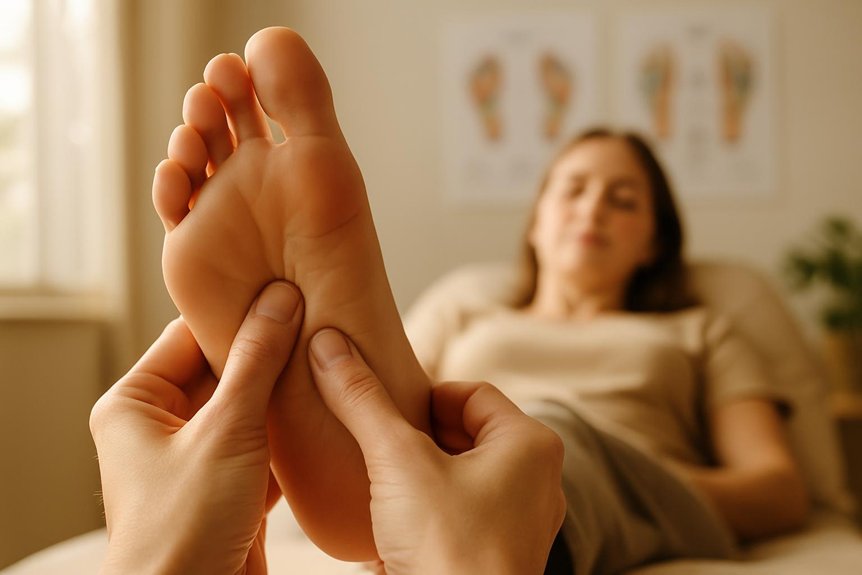
A fundamental aspect of reflexology is its focus on specific pressure points on the feet, hands, and sometimes ears, which are believed to correspond with various organs and systems throughout the body. This modality is grounded in the concept that stimulating these reflex zones can influence internal physiological functions, promoting balance and encouraging the body’s natural healing mechanisms.
Practitioners at Spa & Massage utilise specialised thumb, finger, and hand techniques to target these points, aiming to facilitate relaxation and support overall wellbeing. The underlying principle is that the body functions as an interconnected system, where gentle but precise touch can elicit a calming effect on the nervous system.
A defining feature of zone therapy is its emphasis on the healing power of touch to encourage the body’s innate ability to restore balance and wellness. This holistic approach is tailored respectfully to each individual, fostering a unique sense of connection and comfort during every session.
How This Sessions Are Performed
A typical session at Spa & Massage begins with a brief consultation to assess the client’s health history and wellness goals.
Therapists employ specific manual techniques, such as thumb-walking and gentle pressure application, targeting defined reflex zones on the feet, hands, or ears.
These methods are designed to stimulate nerve pathways and promote systemic balance throughout the body.
Massage Session Process
Typically, what unfolds during a session at Spa & Massage is a structured, client-focused process led by highly trained therapists. The session commences with a confidential consultation, where individual health concerns, lifestyle factors, and therapy goals are discussed in detail.
Following this, the client is invited to recline in a tranquil environment, ensuring comfort and privacy. Therapists perform a brief assessment of the feet, noting any areas of sensitivity or tension.
Throughout the session, communication remains open, allowing therapists to adapt pressure and focus in response to client feedback. The process is designed to foster deep relaxation while supporting specific wellness objectives.
Every aspect—from consultation to session closure—reflects Spa & Massage’s commitment to attentive, personalised care and professional excellence.
Techniques Used by Therapists
How do professional reflexologists achieve therapeutic outcomes during a session? Reflexologists employ systematic pressure techniques, targeting specific reflex points on the feet, hands, or ears believed to correspond with organs and systems throughout the body.
At Spa & Massage clinics, therapists use their thumbs and fingers to apply alternating pressures—known as “thumb walking” or “finger walking”—with precise, rhythmic movements. The appropriate intensity and sequence are selected based on the client’s presentation and goals, fostering both relaxation and targeted physiological responses.
Lubricants such as non-scented oils or creams may be used to facilitate smooth, controlled motion.
Sessions typically progress from general relaxation strokes to focused work on areas of imbalance.
The attentive presence of the therapist and tailored technique enhance both comfort and therapeutic benefit, fostering trust and intimacy throughout the experience.
Key Reflex Points and Their Connections
Several fundamental reflex points on the feet, hands, and ears correspond directly to specific organs and systems within the body, forming the cornerstone of zone therapy practice.
For example, the ball of the foot is typically associated with the heart and lungs, while the arch correlates with digestive organs such as the stomach and intestines.
The tips of the toes are linked to the head and brain, offering a map for targeted stimulation.
Practitioners at Spa & Massage utilise precise knowledge of these points to guide their touch, facilitating an experience that is both methodical and personalised.
Physical and Mental Benefits of this Massage
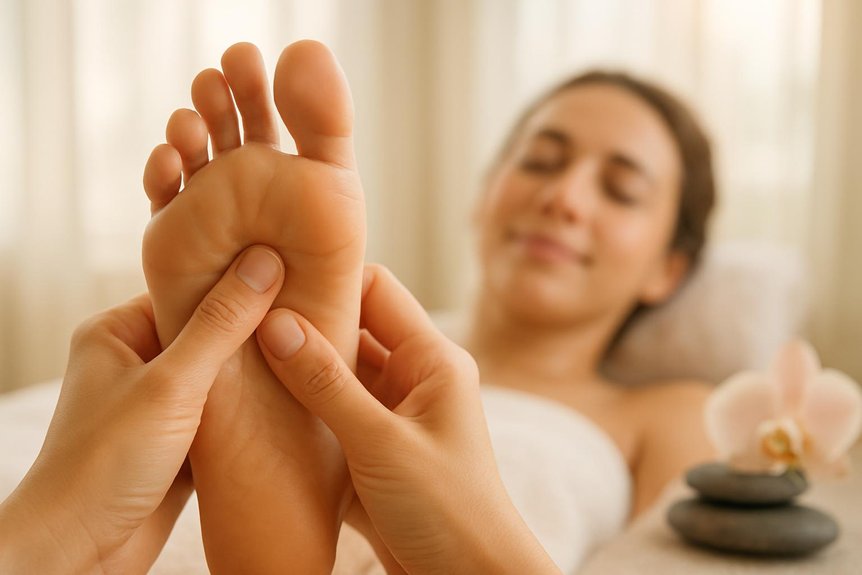
By stimulating targeted reflex points mapped on the feet, hands, and ears, this engages the body’s innate mechanisms for restoring physiological balance. Clinical observations at Spa & Massage indicate that the facilitates improved circulation, reduces muscular tension, and supports homeostasis throughout multiple organ systems.
The application of precise pressure can promote lymphatic drainage, enhance nerve conduction, and encourage the release of endorphins, contributing to a profound sense of physical relaxation.
Mentally, clients frequently report decreased anxiety, heightened mood, and increased clarity following sessions. This massage effects on the autonomic nervous system may promote deeper states of calm and improved sleep quality.
At Spa & Massage, therapists tailor treatments to individual needs, fostering an environment where both the body and mind can recover, rejuvenate, and reconnect.
What to Expect During Your Massage Appointment
An appointment at Spa & Massage begins with a brief consultation to assess the client’s health history, presenting concerns, and treatment goals. This initial discussion guarantees the session is tailored to individual needs, fostering a sense of trust and comfort.
Once the consultation concludes, the client is invited to recline in a tranquil, private treatment room. The therapist sanitises the feet and applies gentle pressure to specific reflex points using precise thumb and finger techniques. Each movement is deliberate, focusing on corresponding zones believed to influence systemic balance and relaxation.
Throughout the session, therapists monitor the client’s comfort, encouraging open communication. The environment remains calm and nurturing, designed to promote deep relaxation and a profound sense of well-being, hallmarks of the Spa & Massage approach.
Aftercare Tips and Recommendations From Our Therapists
Following a therapy session at Spa & Massage, therapists advise clients to maintain ideal hydration. Adequate fluid intake supports the body’s natural detoxification processes post-treatment.
Clients should also allow time for rest and monitor any physical or emotional responses. Observing these aftercare practices can enhance therapeutic outcomes and promote overall well-being.
Hydration and Fluid Intake
Hydration plays a critical role in post-therapy care, facilitating the body’s natural detoxification processes and supporting overall recovery. After a session at Spa & Massage, therapists consistently advise clients to increase their fluid intake, particularly water, to assist in the elimination of metabolic waste products that may be mobilised during treatment.
Ideal hydration supports circulatory efficiency and tissue perfusion, which can enhance the beneficial effects of this massage. Clients are encouraged to consume fresh water gradually throughout the day, rather than in large quantities at once, to promote gentle systemic cleansing and sustained hydration.
This practice aligns with Spa & Massage’s holistic philosophy, fostering the body’s innate capacity for balance and vitality while maximising therapeutic outcomes. Proper hydration remains fundamental to the aftercare process.
Rest and Relaxation
Ideal rest and relaxation are integral components of the aftercare process following a session at Spa & Massage. The body’s parasympathetic nervous system is activated during massage, promoting a state of deep calm that should be preserved post-treatment.
Therapists at Spa & Massage recommend clients allocate time to unwind in a quiet environment, minimizing sensory stimulation and avoiding strenuous activity. Gentle breathing exercises or listening to soothing music may enhance the restorative effects.
Maintaining a tranquil atmosphere allows the physiological benefits of zone therapy to consolidate, supporting *most favorable* circulation and the release of muscular tension.
Clients are encouraged to listen to their bodies, prioritizing self-care and allowing the subtle therapeutic influences of the session to integrate fully, fostering a sense of connectedness and holistic well-being.
Noticing Body Responses
How can clients discern the subtle physiological shifts that often occur after a session?
At Spa & Massage, therapists encourage individuals to attune to nuanced changes such as enhanced circulation, warmth in extremities, or a sense of deep relaxation.
Some may experience mild tingling, increased thirst, or transient fatigue, all indicative of the body’s natural rebalancing processes.
Clients are advised to observe shifts in sleep quality, mood, or digestive regularity over subsequent hours and days.
Our therapists recommend gentle hydration and avoidance of strenuous activity post-session to support the body’s adaptive responses.
Noting these physiological and emotional variations can help clients gain deeper insights into their well-being and maximise the therapeutic benefits unique to this technique at Spa & Massage.
Conclusion
In summary, it remains a compelling modality within holistic health, offering targeted stimulation of reflex points to promote homeostasis and relaxation—much like hitting “refresh” on a computer. Clinical observations indicate that regular sessions can alleviate stress, support wellbeing, and enhance the body’s self-regulatory mechanisms. At Spa & Massage, clients can expect professional, individualized care that integrates ancient principles with modern wellness practices, contributing to a balanced, restorative experience tailored to contemporary lifestyles.

